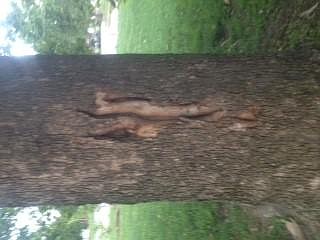Q. I have a large sycamore tree (about 70 years old and nearly 3 feet diameter at the base). A few weeks ago, it began to show patches of missing bark. It is all on the same side of the tree and has three areas straight up the trunk of the tree (see photo). The tree is also losing many patches of bark from the limbs of the tree, but I understand this exfoliating is normal for a sycamore tree. Should I be concerned about the trunk being weakened?
A. It looks more like an area with damaged phloem/cambium layer under the bark, and you have new wound wood growing to cover that area. Sometimes, the expansion that occurs with the new wound wood will split the overlaying bark and it drops off, revealing the damage. If the wood below these areas appears to have any decay or cracks to suggest damage from high winds, it might be worth having an ISA-certified arborist examine it to ensure the tree doesn't pose a safety risk. See treesaregood.com for certified arborists in your area. Rapid development of the wound wood suggests the tree is vigorous and growing well. Practice good tree care to promote health and vigor.
Q. I've started trapping these Japanese beetles. Now what should I do with them? Are they of any use? And they stink!
A. Japanese beetles are gross to deal with. The simplest solution is to put them in a plastic bag and throw it in the garbage. Store it outside somewhere, but if you are where varmints are around, they may be attracted to the bag and tear it open.
Putting them to some use is another matter. For lower numbers, like a full gallon ziplock bag, toss into your freezer overnight. They can then be added to a compost pile, buried around a tree or shrub (good fertility value!) or spread on the ground like a mulch (somewhere hidden or away). Chickens like them and so do some pond fish, but either can grow tired of eating too many.
Another disgusting but effective way to put them to use is to put them in some type of small bags (like ziplock baggies). Smash them up, poke some holes in the bags and then hang them in plants you want to protect. It appears as they decay their stinking mush will be repulsive.
Q. Back in late June, our green beans didn't make pods, and earlier this spring, our radishes didn't fill out the roots. Our garden soil is good, but this spring we mulched around plants with rotted straw and aged manure. Is something wrong?
A. You have two of three classic responses of vegetable crops with too much nitrogen. The third is for tomatoes to grow very lushly and not set fruit with early flowering (sometimes referred to as bullish growth). The application of manure likely is the cause. Manure is often rich in nitrogen.
We encourage home gardeners to apply manure in the fall and till into the soil. It will break down that way and be safer, in terms of microbes that can cause food poisoning. Some have argued aged manure is different from fresh manure in safety, but when it comes to commercial usage of manure, no distinction exists. There is a strict guideline by days from application and time that first harvesting can occur, which is 120 days. So, if a grower applies manure on March 1 (and tills it into the soil) no, repeat NO vegetables should be harvested until July 1. Your radish crop was much faster than that. While home gardeners can do what they want in this regard to manure usage, we feel most want to grow food safely. So in the future, please apply any manure products in the fall. Tilling it in the fall is preferred, but early spring is also OK.
Q. I received a tropical hibiscus as present. Can I plant it outside, or what else might I do with it?
A. It will love the heat and humidity we are having from now through September and will probably grow very fast with abundant flowering. Because of the fast growth, it would be best to put it in a larger pot. Keep it watered and try to place it where it gets six hours of sun daily, at a minimum. You will want to bring it back inside when cold weather starts. Keep in a sunny window for the winter and keep between moist and slightly dry (don't keep it wet for extended periods). Move it back outside around April and increase the size of pot it is in as needed. We don't recommend planting in the soil and then digging it up to bring back inside; that is kind of stressful on plants.

